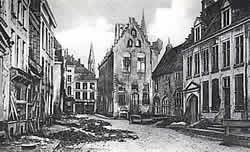 The British Town Major prepares a withdrawal from Ypres
The British Town Major prepares a withdrawal from Ypres
22 April 1915: 24.00
From 5.30pm the town of Ypres was again on the receiving end of a very heavy and continous bombardment by the German long-range artillery. From the start of the German attack and on into the night there were terrified, traumatised civilians streaming towards Ypres from the outlying villages and farms. Ypres was suffering serious damage to its buildings and water supply by 22nd April. Most were heading west in the direction of the railway station at Vlamertinghe in the hope of getting a train to Poperinghe and relative safety away from the shelling. The last train left for Poperinghe at midnight, packed with the elderly, children, women and wounded soldiers. Even after the train had gone there were still more people making their way along the Ypres-Poperinghe road on foot.

|
The War Diary of the Town Major of Ypres, Lieutenant-Colonel Hankey, describes the situation:
“Severe bombardment started about 5.30pm and continued without a pause till I left the following day at 10.30am.
During the night I left my office in the Rue Carlton and went to the Cloisters north of the Town Hall where I found about 25 A.S.C. [Army Service Corps] of the 28th Division, and put them under my orders. I wired for instructions from the 5th Corps Headquarters as to my withdrawal. I advised the Belgian Military Governor to leave the town. All his Travailleurs [working parties] had left the town, as well as his Gendarmerie. All the road Guards had been withdrawn. Inhabitants were leaving in a steady stream.” (1)
Next>> Allied losses by the end of the day
Acknowledgements
(1) War Diary of the 5th Army Corps, DA & QMG for the month of April 1915 dated 30/4/15: ref. WO95/4048